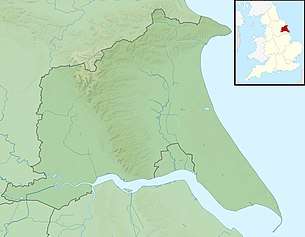Gypsey Race
The Gypsey Race is a winterbourne stream[3] that rises to the east of Wharram-le-Street and flows through the villages of Duggleby, Kirby Grindalythe, West Lutton, East Lutton, Helperthorpe, Weaverthorpe, Butterwick, Foxholes, Wold Newton, Burton Fleming, Rudston and Boynton. The stream flows into the North Sea in Bridlington harbour. It is the most northerly of the Yorkshire chalk streams.[3]
| Gypsey Race | |
|---|---|
.jpg) Gypsey Race near Bridlington | |
 Location of the mouth shown within the East Riding of Yorkshire | |
| Etymology | Gypsia[note 1][1] |
| Location | |
| Country | England |
| Physical characteristics | |
| Source | |
| • location | Duggleby |
| • coordinates | 54°5′21″N 0°39′33″W |
| • elevation | 114 metres (374 ft) |
| Mouth | |
• location | North Sea at Bridlington |
• coordinates | 54°4′52″N 0°11′27″W |
| Length | 41.4 kilometres (25.7 mi)[2] |
| Basin size | 265.5 square kilometres (102.5 sq mi)[2] |
The Gypsey Race rises in the Great Wold Valley[4] through a series of springs and flows intermittently between Duggleby and West Lutton where it runs underground in the chalk aquifer before re-surfacing in Rudston. It has been known during very wet conditions for the stream to re-appear at Wold Newton[5] some 4.3 miles (7 km) north west of Rudston.[6] Water from the aquifer running between West Lutton and Wold Newton also heads south to re-appear at Elmswell feeding West Beck and the River Hull.[5]
According to folklore, when the Gypsey Race is flowing in flood (The Woe Waters), bad fortune is at hand.[7] It was in flood in the year before the great plague of 1664, the restoration of Charles II (1660) and the landing of William of Orange (1688), before the two world wars and the bad winters of 1947 and 1962.[1]
The stream also badly flooded the village of Burton Fleming in 2012 when the water was 2 feet (0.61 m) deep in places.[8]
Villagers in Boynton have an annual duck race on the stream in May. Hundreds of yellow plastic ducks are paid for and race the Race in aid of funds for the village hall.[9]
Pictures
Notes
- From the Old English Gypsia meaning to suddenly spring into life
References
- Hulbert, Linda (21 May 2008). "Origin of the Gypsey Race". Bridlington Free Press. Retrieved 4 November 2016.
- "Gypsey Race from Source to North Sea". Catchment Data Explorer. Environment Agency. Retrieved 4 November 2016.
- "Gypsey race" (PDF). eastyorkshireriverstrust.org. East Yorkshire Chalk Rivers Trust. April 2008. p. 2. Retrieved 4 November 2016.
- "Great Wold Valley Heritage Trail" (PDF). ryedaleconnect.org. Ryedale District Council. p. 1. Retrieved 4 November 2016.
- "Gypsey Race - Summary". Catchment data Explorer. Environment Agency. Retrieved 4 November 2016.
- "101" (Map). Scarborough & Bridlington (D2 ed.). 1:50,000. Landranger. Ordnance Survey. 2006. ISBN 9780319229057.
- Cooper, A. N. (1921). The Curiosities of East Yorkshire. Scarborough: E. T. W. Dennis. OCLC 19825990.
- Townend, Jon (27 December 2012). "Burton Fleming residents bailing out after floodwater enters homes". Hull Daily Mail. Retrieved 4 November 2016.
- "Bottoms up at Boynton". Bridlington Free Press. 6 May 2010. Retrieved 4 November 2016.
External links
![]()
.jpg)
.jpg)